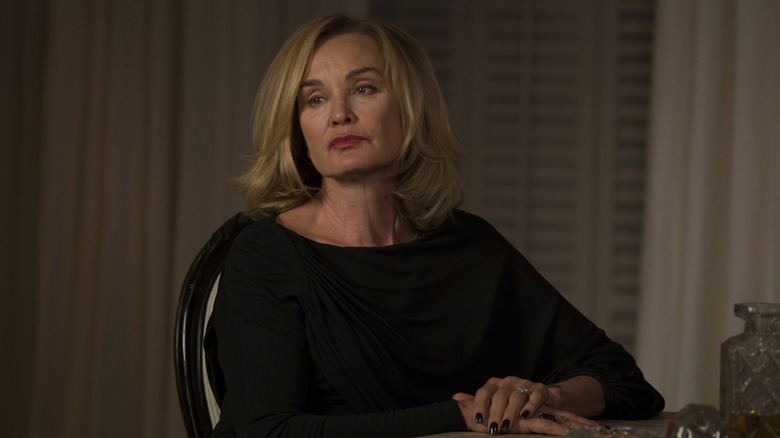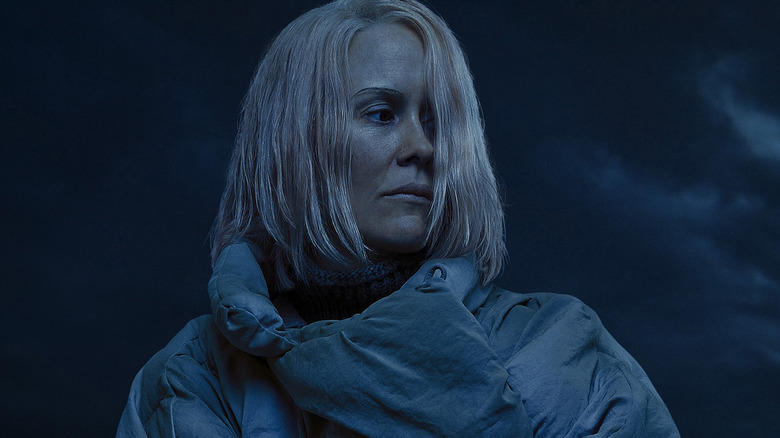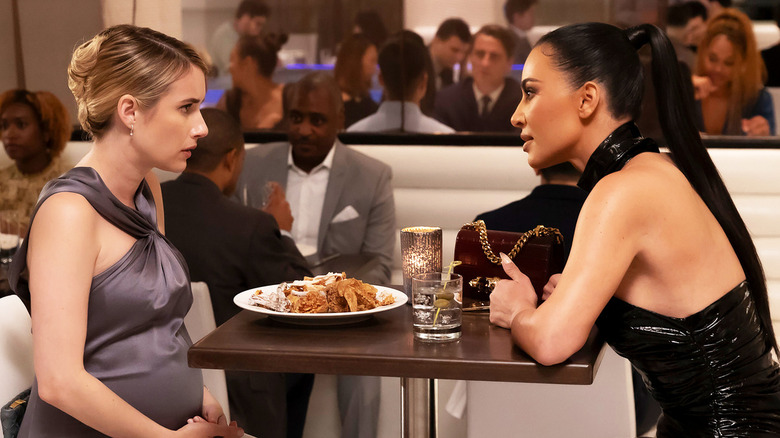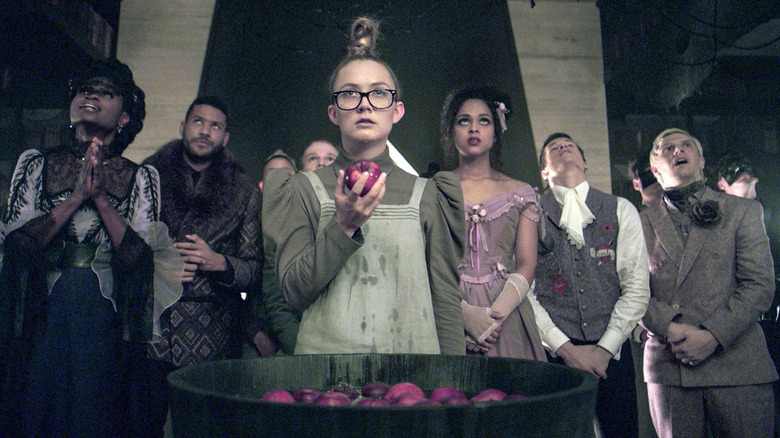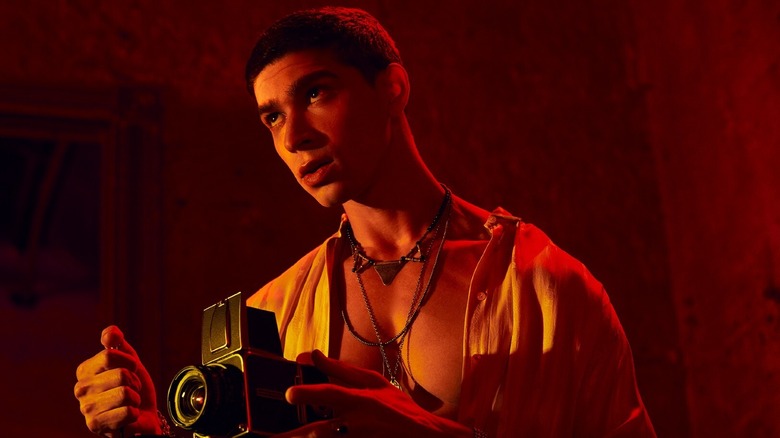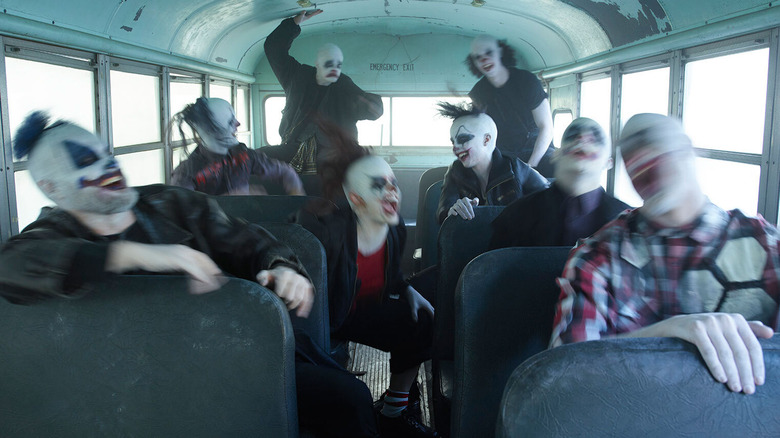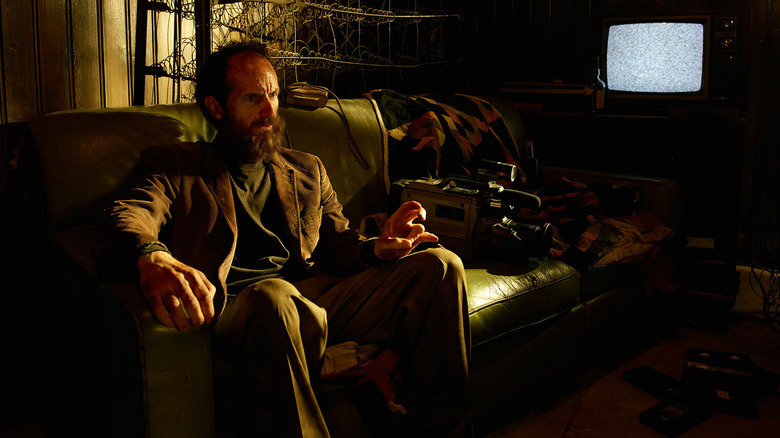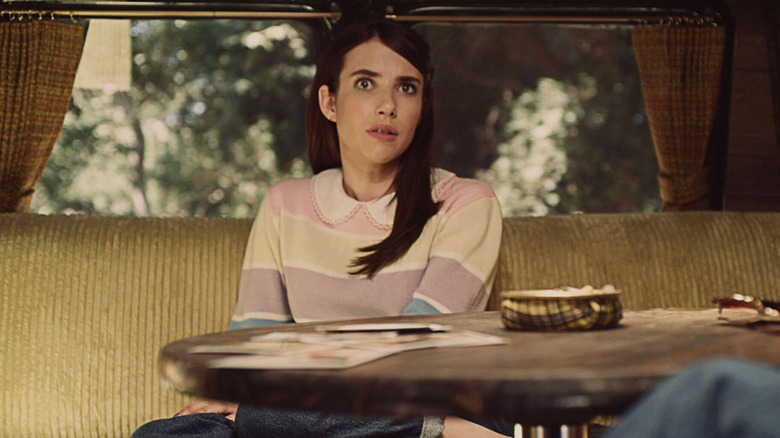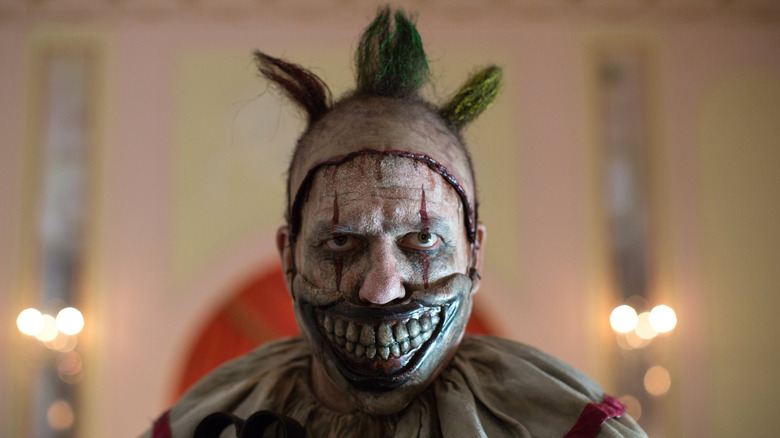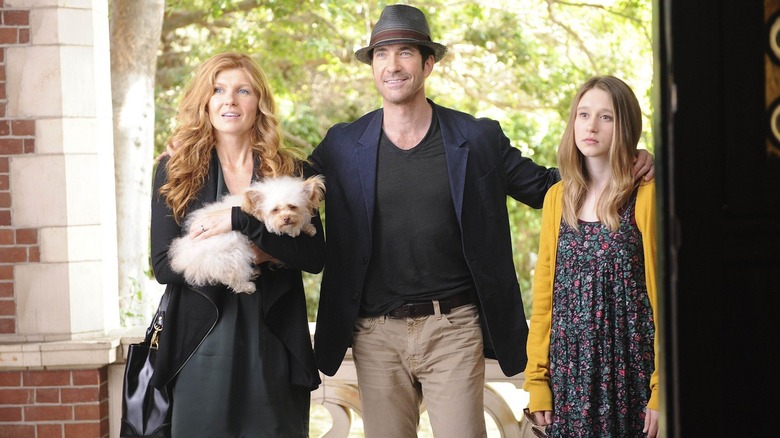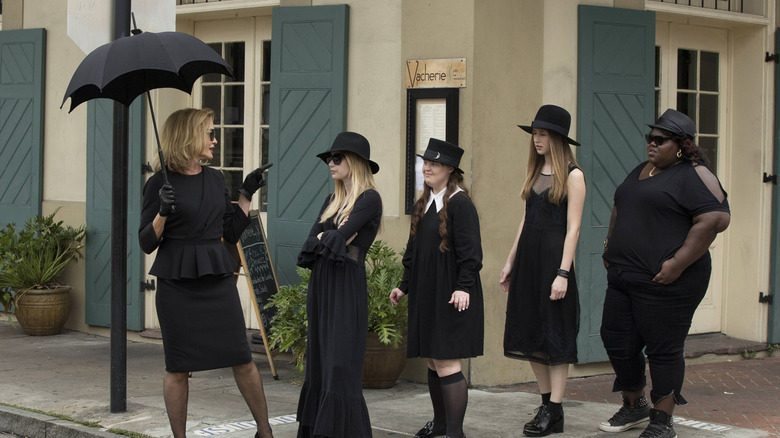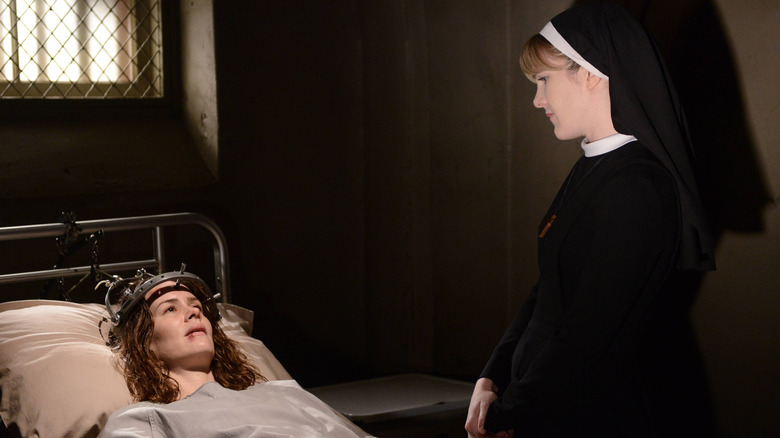All 12 American Horror Story Seasons Ranked
Sometimes chilling, sometimes campy, and always memorable, "American Horror Story" has 12 seasons under its belt as of this writing, and in that time period it's introduced plenty of unforgettable characters, catchphrases, and stories into the pop culture zeitgeist. Some of the tales they've presented have captivated audiences for months, while others have faded away, leaving fans frustrated and annoyed by the narrative choices made within those episodes.
"American Horror Story" has always had terrible problems sticking the landing, which has resulted in plenty of unsatisfying endings. And yet sometimes the show has provided soul-crushing — or soul-lightening — conclusions to the terrors that have come before it. Which seasons are the best of the best, and which ought to be consigned to the dustbin of history? The following list ranks each season of the show via authorial preference as well as common sentiments as to how each batch of episodes ultimately worked out and their relative cultural impact.
12. Double Feature
Easily the worst of the worst, "Double Feature" is a drag of a series, taking interesting performances and unique concepts and allowing them to sputter to an unsatisfying dual conclusion. In the first half of the season, "Blood Tide," a small family moves to Provincetown, Massachusetts during its off season. In the winter months, the crowds are sparse, mainly populated with artists fleeing the New York scene. Harry Gardner (Finn Wittrock) soon learns about the town's dirty secret. He's passed a pill called Muse, which enables incredible powers in the user, especially those experiencing creative blocks. Unfortunately, it also turns you into a cannibalistic, blood-craving vampire. And if you aren't truly talented, swallowing Muse will make you lose your mind.
In "Death Valley," a group of campers are horrified to discover that they're now the final frontier between alien and human interactions — literally, as they're all mysteriously pregnant after encountering an alien craft. They're swept away to Area 51, where the history of human and alien fraternization is slowly revealed to them, and the true desires of their alien captors are revealed.
Perhaps the problem was the limited amount of time each story was given to develop, or how highly constrained the two concepts were. It's a shame, because the vampire storyline in particular was very interesting, but in the end, unsatisfying.
11. Delicate
"Delicate" is a victim of two big problems: A long break engineered by the COVID-19 pandemic and a lackluster conclusion that feels divorced from its propulsive first half. A few things save it from the bottom of the heap, namely a good performance by Emma Roberts, and a unique idea that confronts the power of ambition and the horrors of pregnancy.
Anna Alcott (Roberts) wants nothing more than to win and Oscar and be a mother. Both prospects seem to be impossible goals: She keeps miscarrying, is undergoing a stressful IVF cycle, and her Oscar hopes are seemingly dashed by embarrassing press incidents. Convinced that she's being stalked, horrible physical manifestations begin to haunt her. While Anna does get an Oscar nomination and end up pregnant, she may have to pay a terrible price for both victories.
This is the first time an "American Horror Story" series has been based on other media — the book "Delicate Condition" by Danielle Valentine — and perhaps staying so loyal to the source material stymied the show from reaching its full potential. In any event, it's not the worst but definitely not the best outing in the show's history.
10. Apocalypse
What starts out as an interesting, fresh concept in "American Horror Story" history turns into a reappraisal of two of its most popular seasons, "Coven" and "Murder House," which ultimately makes "Apocalypse" stale business. Not even a legendarily campy performance by Joan Collins can turn this one around.
It's the end of the world, and a small group of powerful people have secreted themselves away in Outpost 3, which used to be a school for warlocks. The goal is to repopulate the world, or at least hold on until they can figure out how to survive, but supplies are low and hope is dwindling. Then a fully-grown version of Antichrist Michael Langdon (Cody Fern) makes himself know. He declares it'll be his job to figure out who's worthy of surviving the apocalypse — until a coven of witches from New Orleans arrives to stop him.
While it improves a couple of leftover problems related to "Coven" and solves a big issue left behind by "Murder House," it feels as if Ryan Murphy can't resist going all the way into the past, and in rewriting his earlier choices weakens three seasons at the same time. It's a real pity, because it could have been quite the different tale. Still, it has its supporters — and even contains one of Ryan Murphy's favorite episodes of the show. But this is the season where some long-time fans stopped watching "American Horror Story," so proceed with caution.
9. NYC
"American Horror Story: NYC" does the best job of trying to reflect Ryan Murphy's feelings about being a gay man who has seen the impact of the AIDS crisis on his community, throwing in tributes to the queer club scene and queer slasher films like "Cruising." Unfortunately, "NYC" didn't make much of a cultural impact on the world at large, and is probably the most-obscure and least-talked about of all of the show's seasons. It's not a dire showing, but it's definitely not the best of the bunch.
Gino Barelli (Joe Mantello) is a reporter whose boyfriend, Detective Patrick Read (Russell Tovey), is curious to know more about a serial killer who's been plaguing leather bars and clubs in the area. The killer is nicknamed "Big Daddy" and is dressed to match a common look in the leather scene. Gino and Patrick are slowly drawn into a terrifying mystery which also includes a virus that has begun to spread across Fire Island and Big Daddy keeps on metaphorically spreading across the community with his slayings. The two tales intertwine into an intense look at the horrors and beauties of life in the queer community of New York in the 1980s.
8. Cult
A number of things work in the sprawling world that is "Cult." It and "Roanoke" both fall in the solid middle when it comes to "American Horror Story" seasons because they present memorable characters or ideas but end up sprawling onto their backs, displaying Ryan Murphy's biggest storytelling flaws and worst quirks. But for what they are, they're quite entertaining.
Ally Mayfair-Richards (Paulson) and her wife Ivy (Alison Pill) seem to have an ideal relationship, though Ally has severe panic attacks and phobias. The couple begin to receive harassment from their neighbors, specifically from a group of people dressed like clowns that only their son and Ally seems to notice. Ally finds herself speed-running toward a breakdown. She meets the acquaintance of local politician and cult leader Kai Anderson (Peters), who has begun to develop a foothold among his constituents thanks to his go-for-broke attitude. While he woos Ally into his fold, it turns out that he's got major plans for his cult's success brewing.
"Cult" sports a surprisingly solid turn from Chaz Bono and some of the best work Evan Peters and Sarah Paulson ever did for the franchise. But it's far too inconsistent to be considered top-tier among the "American Horror Story" series.
7. Roanoke
Seen through a variety of metatextual formats, "My Roanoke Nightmare" chronicles the difficulties experienced by married couple Shelby (Lily Rabe) and Matt Miller (André Holland), who move to Roanoke looking for peace and quiet. They do not get it, as the land their house is situated upon is cursed by the ghosts of Roanoke Colony, their souls sold to a mysterious woodland entity by Thomasin White (Susan Berger), the former first lady of colony. Multiple families experience what the Millers do over the years — and some of them aren't as lucky in their escape. Instant fame and greed quickly set in, with missing loved ones, blood sacrifices, and the horrors of coping with the weight of ones' selfishness.
This is the most divisive entry in the series due to the fact that much of "Roanoke" takes place in a confusing, sliding-scale sort of reality. Some parts of it are quite fascinating, and its commentary on reality shows and their impact on the culture remains unique. But the complicated plotline is almost too sophisticated to keep pace with its ambitions, leaving the viewer behind — it doesn't quite beat the middle of the pack because of that, but it's still an interesting outing.
6. 1984
"1984" was the last time "American Horror Story" was actually fun. Spirited, arch, and filled with knowing nods, it's the season that remains the best pick when you want a breezy watch. It's also arguably the only time Ryan Murphy managed to import a real-life serial killer into his narrative – Zach Villa's take on Richard Ramirez — in a successful manner. It's a riot to take in, something that the show hasn't been in years and hasn't been since.
Brooke Thompson (Emma Roberts) is a sweet-as-pie virgin who had a horrible and aborted wedding she doesn't want to talk about. Her aerobics class friend Montana Duke (Billie Lourd) talks her into acting as a camp counselor in the recently reopened Camp Red Pines, where a serial killer named Mr. Jingles (John Carroll Lynch) was accused of murdering dozens in the 1970s. Unsurprisingly, when Brooke, Montana, and the rest of their fellow camp employees show up to begin opening up the place for new visitors, bodies start piling up, leaving everyone's survival in question. A high body count, and some surprising twists and turns leave the future of Camp Red Pines in major doubt — and then some.
5. Freak Show
The titular "Freak Show" belongs to Elsa, who yearns for true fame but loves her family of freaks deeply. Bette and Dot join the show after they're found beside their murdered mother. They soon become enmeshed with their fellow performers — including Jimmy Darling (Evan Peters), a boy their age with hands shaped like lobster claws. Rich, psychotic mama's boy Dandy Mott (Finn Wittrock) soon poses a threat to the troupe, as does a collector of freaks, and it will take much bravery for them to make their way out with their bodies and souls intact.
The tender heart of "Freak Show" lies in its memorable characters — ringmistress Elsa Mars (Jessica Lange), the silent but scary Twisty the Clown (John Carroll Lynch), conjoined twins Dot and Bette Tattler (Sarah Paulson), and the sweet, tiny Ma Petite (Jyoti Amge). It has some memorable kills, and set pieces that make it stick out. On top of that, it feels like a linear, cohesive package that works from top to bottom. Not many "American Horror Story" seasons can say that about themselves. One could even call it one of the saddest "American Horror Story" seasons. But it's slightly less iconic than four other installments of the show, landing it in fifth place.
4. Hotel
"American Horror Story: Hotel" spotlights the Hotel Cortez, a former luxury hotel haunted by ghosts literal and metaphorical, as well as a flock of vampires. Loosely based on the real-life Cecil Hotel — a California hostel noted for repeated tragedies and crimes, as well as hosting at least one serial killer, Richard Ramirez, the show shines when it concentrates on its quirky characters. These include The Countess (Lady Gaga), head vampire whose favorite hobby is to save and then turn abused children; Liz Taylor (Denis O'Hare), who finds her true self as the hotel's desk clerk; and Ramona Royale (Angela Bassett), The Countess' spurned lover, a B-movie starlet. The narrative arc gets muddy, but when it pauses for visits to California's silent movie past, it feels decently integrated.
The central mystery of the season focuses on Detective John Lowe (Wes Bentley) whose personal and professional life begins to unravel as he becomes more and more entangled with the mystery of the Cortez. The other character's stories work in and out of his, but it begins and ends with Lowe and The Countess, who are, in their own special ways, trapped and pinned in by the building they are devoted to.
3. Murder House
The first season comes very close to being the best, but "Murder House" just misses the top spot for being not quite as iconic or consistent as the two seasons that followed it. It does have a unique feeling to it, and it's a wonderful take on the doomed haunted house trope that manages to be creepy, kinky, sad, and romantic at the same time. It lives up to the critical hype in more ways than one.
The central figures this time out are the Harmons — matriarch Vivien (Connie Britton), who recently experienced a miscarriage and yearns for another baby, patriarch Ben (Dylan McDermott), who cheated on Vivien with a student of his and has gone back into practicing psychiatry, and Violet (Taissa Farmiga), a depressed teenager. The Harmons begin to encounter strange goings-on in their home, and Violet falls for the mysterious Tate (Evan Peters). What seems like simple nosiness from neighbor Constance Langdon (Jessica Lange) conceals something much darker — that the Harmon's home is a very cursed place indeed, and everyone who lives there is in mortal danger. Who will live, who will survive, and who happens to already be dead is revealed slowly over the show's short run.
2. Coven
Undoubtedly the most memetic edition of "American Horror Story," "Coven" fans can easily rattle off a dozen quotes by heart — especially Madison Montgomery's (Emma Robert) "Surprise, b****. I bet you thought you saw the last of me." Then there's "Balenciaga!," "This coven doesn't need a new Supreme. It needs a new rug," and "Don't be a hater, dear." The list is endless. But "Coven" can't rise any higher in the race due to a weak middle section and a somewhat disappointing ending, which has been re-written thanks to canonical reappraisal via "American Horror Story: Apocalypse." Still, it's a fun season that mostly works and is a must-watch for horror fans as well as devotees of the series, even if it's loaded with moments that went too far.
Zoe Benson (Taissa Farmiga) discovers her powers in the middle of making love to her boyfriend. This is how she finds out she's a witch. Her parents send her to the New Orleans-based Miss Robichaux's Academy for Exceptional Young Ladies, where her powers will be honed and she will be protected. Zoe soon meets her fellow witches, all of whom have traumatic incidents in their past. It turns out that every Coven has a Supreme — in this case, Fiona Goode (Jessica Lange). When she begins showing signs that — like every Supreme before her — she will finally shuffle off the mortal coil, leading to one of her potentials becoming the next Supreme, a fight for dominance within the coven sets in, complicated by voodoo, ghosts, and the New Orleans' barely buried history of racism.
1. Asylum
"Asylum" is as close as "American Horror Story" ever got to being prestige television. Narrative fumbles aside (distasteful Anne Frank arc, we're looking at you — definitely one of the most controversial moments in "American Horror Story" history), this is a pretty perfect season. It does a good job both telling a dark story about its characters and striking a blow for queer liberation and mental health rights all at once. And there are aliens, to boot. It even contains a scene that brought Sarah Paulson to tears.
Set at Briarcliff Manor, a mental institution, the season follows ambitious journalist Lana Winters (Paulson), who plans on jumpstarting her career by going undercover as a patient and letting the world know how awfully everyone is being treated by the nuns and doctors on-staff. Among the colorful cast of characters she encounters along the way are Sister Jude (Jessica Lange), a lounge singer-turned-nun trying to pray away her guilt after committing vehicular homicide, accused serial killer Kit Walker (Evan Peters), and Sister Mary Eunice McKee (Lily Rabe) who is possessed by a demon. Hovering over them all is Bloody Face, a serial killer who may make their New England rest cure very brief.
